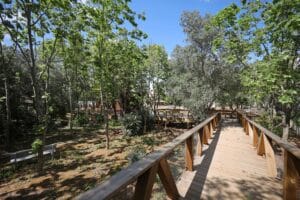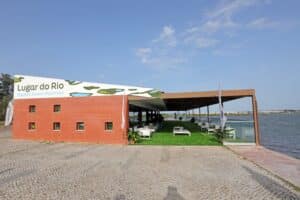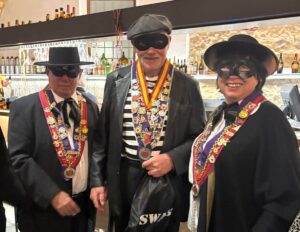With the festive season upon us why not go traditional and enjoy the best Algarvean seafood on offer, fresh from the ocean?
By Patrick Stuart patrick.stuart@open-media.net
Portuguese tradition states that Christmas dinner should be bacalhau (salted cod) on December 24 and, to a lesser extent, roast turkey on Christmas day. Both dishes vary widely in their preparation from region to region; but one thing all Portuguese love to eat over the festive season is seafood. This is especially true at New Year, but throughout the holidays all manner of crustaceans and molluscs are consumed with relish.
At the large mainstream supermarkets, the majority of seafood tends to be either frozen, imported or usually both. Even the live lobsters and common brown crabs (sapateira) crawling around in the tanks are all imported.
Frozen prawns, in their numerous different sizes, come from as far away as Thailand and, more commonly, off the coast of East Africa. When buying frozen prawns, it is worth checking if they are captured from the ocean rather than farmed, as many of the farmed prawns (usually those that seem extremely cheaply priced) have been pumped up with growth hormones and the quality is usually very poor.
But with the bountiful Atlantic ocean lapping at our shores, I for one have always preferred to eat local.
For the best selection of local “frutos do mar”, visit one of the Algarve’s better municipal markets such as Lagos, Portimão, Armação de Pêra, Quarteira, Faro or Olhão. There are also good specialist seafood shops in some towns.
Remember what’s on offer and then look for it on restaurant menus or, even better, prepare a festive feast of fresh seafood yourself. Here’s what you’re likely to find, plus some simple instructions for cooking.
Gambas
This is the standard variety of prawn found off the Algarve coast and available throughout most of the year at local markets. They are usually around 6 to 7cm in length.
Cook them in their shells, either boiled or fried: Boiled – add some rock salt to water and bring to the boil, throw in the prawns and wait until the water just starts to boil again. This should be enough cooking but try one to check. If they are slightly underdone just leave them covered out of the water for a couple of minutes. Perfectly cooked, the meat should be firm and juicy – a few seconds longer will turn them soggy. Once done, run under cold water to halt the cooking process. Fried – There are many different methods of frying prawns; some people favour butter, others olive oil. Personally, I like to use a good slug of virgin olive oil plus a knob of butter. Heat the oil, butter or whatever in a heavy-bottomed frying pan then throw in a few cloves of slightly crushed whole cloves of garlic. Fry the garlic until soft, not brown, then add enough prawns to loosely cover the base of the pan and season with rock salt. Do not fry too many at once as the skins will not crisp properly. Fry on one side over high heat for a minute or so then individually turn them over and continue to fry over reduced heat until the tails have all curled. Total cooking time per pan-load should be no more than three minutes once the prawns are added. The prawns should be served with the cooking oil (add some piri-piri oil towards the end if desired) and the garlic cloves, great for soaking up with crusty bread. The tastiest bits of well-fried prawns are the legs which can be chewed off before peeling the shells.
Carabineiros and Camarão Vermelho
These are alternative varieties of local prawns which are less easy to find, a great deal more expensive and are characterised by their deep red colour.
Carabineiros can be distinguished from camarão vermelho by their elongated heads and a horn-like spike which protrudes from their head. Carabineiros also tend to be larger and can often reach the proportions of large tiger prawns. Despite these differences, the flavour is common to both and quite different from gambas. The meat is both sweeter and of a far more delicate texture. Cooking instructions are similar to gambas but times should be reduced even further as the delicate meat can easily overcook and become powdery.
Large carabineiros can also be sliced down the middle and grilled.
Lagosta
Often referred to in English as the spiny lobster but correctly named crawfish, the lagosta is the most prized crustacean found off the Algarve coast. The common lobster (with claws) is not abundant in these parts and the only other common type of lobster seen here is the rock lobster, known in Portuguese as ferreirinhas or bruxinhas. The meat of the crawfish is considered by most chefs as superior to that of the lobster and carries a higher price tag. It is worth noting that pretty much all common lobster found for sale here in Portugal is imported live from elsewhere in Europe.
If it has been sitting in a tank for weeks or months after having been shipped then the chances are the meat will have shrivelled somewhat and gone tough as the crustacean starves. So when buying lobster always keep this in mind: if a retailer or restaurant has a good turn-around of the crustaceans the quality is assured.
There are countless recipes for lobster and crawfish but the Portuguese favour simple boiling in salted water. The lagosta should be boiled live and served either hot or cold according to personal taste. If you’re lucky, you may also find lagostins at the market (langoustines) although they are becoming increasingly scarce.
Perceves
This is a variety of barnacle (known in the UK as the goose barnacle) that clings to the rocks around the tide line on the Algarve’s west coast. They are daringly hand-collected by fishermen who clamber over the rocks, getting very wet and sometimes injured in the process. So why all the effort? Well, to many die-hard locals, perceves are the embodiment of seafood in its purest form – they actually taste of the sea. To cook, boil up just enough water to cover the perceves in a saucepan, add some rock salt, throw them in and take them out as soon as the water comes back to the boil. Leave to cool for a few minutes which will also finish off the cooking. To eat, hold the crusty bit on the end between finger and thumb and twist off the trunk-like skin with your other hand. The flesh underneath is edible.
Amêijoas
The Algarveans are pretty passionate about their amêijoas (clams) and rightly so. The contamination scare earlier this year is no longer of concern and clean waters of the Ria Formosa lagoon produce some of the finest clams you will find anywhere. Not only are they eaten on their own but also form the essential ingredient of the Algarve’s most famous dish, the cataplana and the tasty Alentejo speciality of fried pork with clams (carne de porco à alentejana).
But the most common way of preparing amêijoas (and my favourite method) is known as “à bulhão pato”. There are various types of clams available and the best are usually the most expensive, identified by their dark grey or black shell. The white-shelled clams are of inferior quality.
To cook, put a splash of virgin olive oil in a saucepan and heat, then add a few cloves of garlic, skinned and slightly crushed, plus a pinch of rock salt. Soften the garlic then add the clams and cover the pan. Leave for a few minutes and keep checking until all the shells have opened. No water or wine need be added as the water in the clams will escape and mix with the oil and garlic to form the sauce. Remove from the heat and throw in a handful of chopped coriander. Mix around and serve with plenty of good crusty bread for the sauce. Discard any clams that have not opened.
Conquilhas
No translation for these but they are similar to a clam only flatter in a slightly elongated shell. Conquilhas also tend to be smaller and while less expensive than good quality clams, just as highly regarded. Cook in the same way as ameijoas.
Santola
A good santola (spider crab) from the Algarve is hard to beat. Personally, I prefer it to any lobster but it’s all a question of taste.
With santola, bigger usually means better, although I have seen huge crabs with little meat inside. This is usually the result of the crab (as mentioned above regarding lobsters) being undernourished during captivity. A good crab will be heavy for its size, although this is difficult to judge for the uninitiated.
In the Algarve, santola is eaten warm whereas elsewhere in Portugal they are preferred cold. To cook, the crab must first be killed, to avoid the legs from dropping off during cooking which allows water to flood the meat. Turn the crab on its back and lift the flap which conceals a small hole. Using a meat skewer, stab deep into the body through this hole which will render it dead almost immediately. Next, simply place in a pan of boiling salted water, bring back to the boil and cook for around 20 minutes for a 1-kilo crab plus 10 minutes per extra kilo.
The common brown crab (sapateira in Portuguese) is not native to these waters and is imported live in vast quantities. Around Christmas time supermarkets tend to receive large deliveries and if eaten before they become undernourished they are an excellent and considerably less expensive alternative. Cook the same way.
Eat in or out?
Seafood is generally easy to prepare as long as cooking times are respected, but it can be messy. To find a good selection of fresh local seafood in restaurants is not easy. But there is one restaurant in the Algarve that can always be counted on to offer a full selection of local fare – Marisqueira Rui in Silves. It is well known throughout the region and beyond. Elsewhere most towns have one or more marisqueira (seafood restaurant or bars) where you can find a fair selection of fresh seafood pre-cooked or cooked to order. It’s worth noting that these establishments provide a take-away service if asked.

























